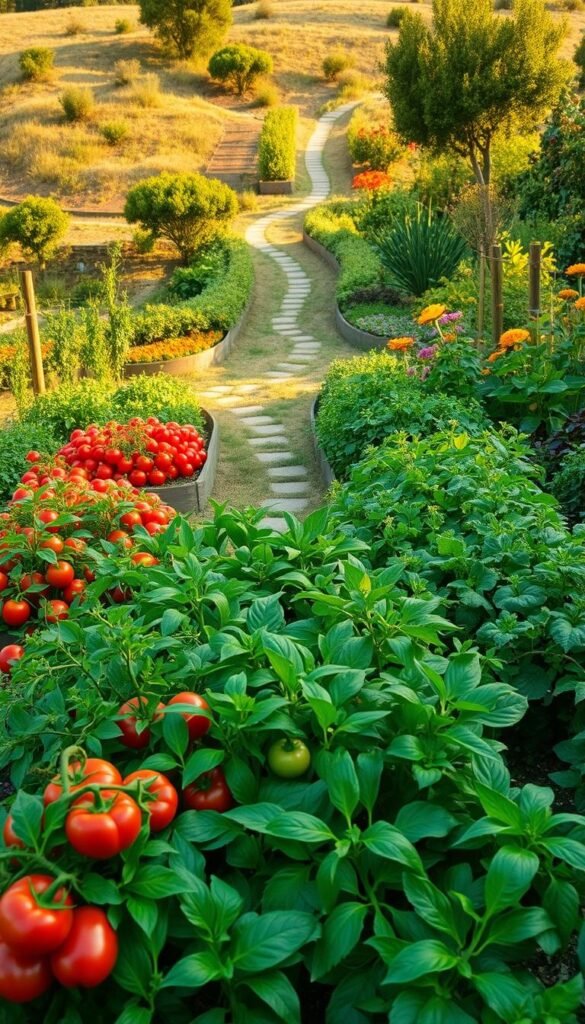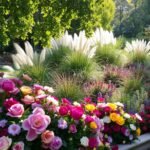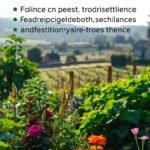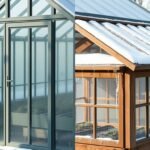Imagine stepping into your yard and plucking fresh herbs between bursts of lavender blooms or snacking on cherry tomatoes nestled beside marigolds. This landscape isn’t just pretty—it’s productive. More Americans are rethinking their outdoor spaces, blending vibrant flowers with nutrient-packed greens to create living pantries that dazzle the eye.
Once seen as purely practical, food-growing areas now rival ornamental displays in curb appeal. Modern gardening enthusiasts are proving that kale can be as striking as roses when arranged thoughtfully. These spaces do more than feed families—they attract butterflies, reduce grocery bills, and turn soil-tending into a daily joy.
You’ll discover how mixing textures and colors transforms ordinary plots into eye-catching arrangements. From vertical strawberry towers to basil borders framing flowerbeds, every inch serves a purpose. Even balcony growers can craft lush, edible displays using clever container strategies.
This approach builds on traditions like French potager gardens, where aesthetics meet harvests. By prioritizing both form and function, you’ll create a landscape that nourishes body and soul while boosting your home’s charm.
Ready to rethink your patch of earth? Let’s explore how to weave beauty into every bite.
Understanding the Essentials of Your Edible Landscape
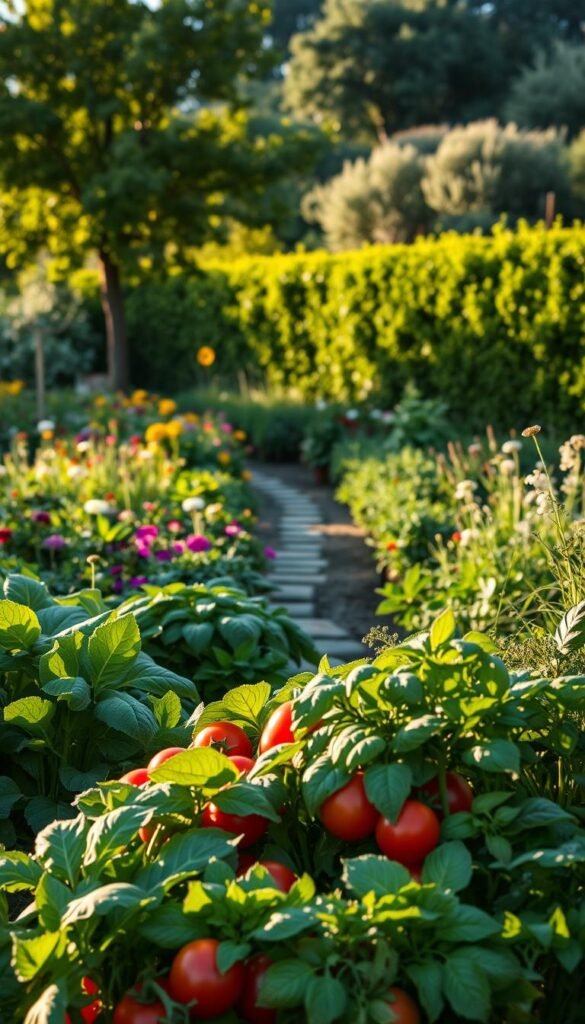
Picture your morning coffee enjoyed under the dappled shade of a blossoming apple tree while bees hum around nearby lavender. This is the power of edible landscapes—spaces where every element pulls double duty. Let’s break down how to balance practicality with charm.
Nature’s multitaskers: Plants that work hard
Fruit trees anchor your space with height and seasonal drama. Dwarf varieties like ‘Honeycrisp’ apple or ‘Stella’ cherry thrive in tight spots while delivering full-sized harvests. Their spring blossoms become summer’s juicy rewards.
Berry bushes like blueberries transform fences into living pantries. These compact powerhouses offer spring flowers, summer snacks, and fiery autumn leaves. Pair them with flowering herbs—thyme spills over edges while mint repels pests naturally.
The circle of growth: Partners in productivity
Strategic pairings create thriving ecosystems. Marigolds shield tomato roots from nematodes, while chamomile improves nearby plants’ flavor. Tall sunflowers support bean vines, proving functionality fuels beauty.
Pollinator-friendly flowers like coneflowers and bee balm aren’t just pretty—they’re essential workers. A single lavender plant can attract hundreds of beneficial insects weekly, boosting yields across your edible landscape.
Vegetable Garden Design Ideas: Combining Beauty with Bountiful Harvests
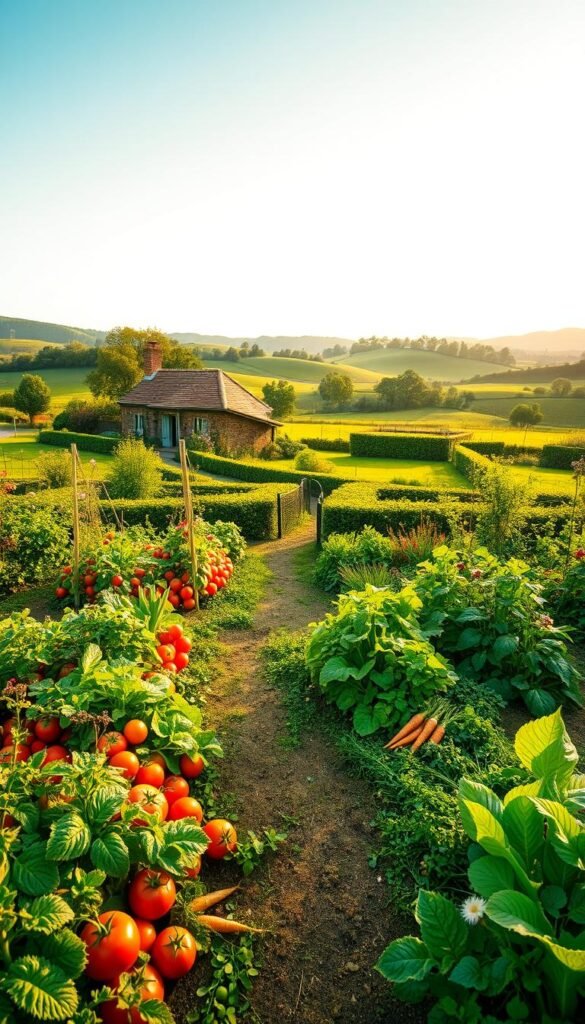
Your patch of earth holds endless possibilities. Whether working with acres or a fire escape, smart planning turns any area into a feast for the senses. Start by sketching sunlight patterns and soil quality across your plot—these factors determine what thrives where.
Mapping Your Growing Canvas
Measure every corner. Sunny spots become tomato stages, while shaded nooks host leafy greens. Even narrow side yards work—install vertical planters for strawberries or pole beans. Remember: productive spaces needn’t be rectangular. Curved beds add flow, while tiered planters create depth.
Curating Your Living Palette
Mix textures and colors for year-round interest. Pair purple basil with golden marigolds, or let rainbow chard brighten flower borders. Consider these star performers:
| Plant | Height | Season | Companion |
|---|---|---|---|
| Nasturtium | 12″ | Summer | Cucumbers |
| Rosemary | 36″ | Year-round | Carrots |
| Kale | 24″ | Fall-Spring | Marigolds |
Add structural flair with arched trellises for grapes or creative gardening ideas like repurposed ladders for snap peas. Dwarf fruit trees make fragrant focal points, while thyme spills beautifully over stone paths. Rotate crops seasonally to maintain visual drama and continuous harvests.
Incorporating Creative Edible Planting Techniques
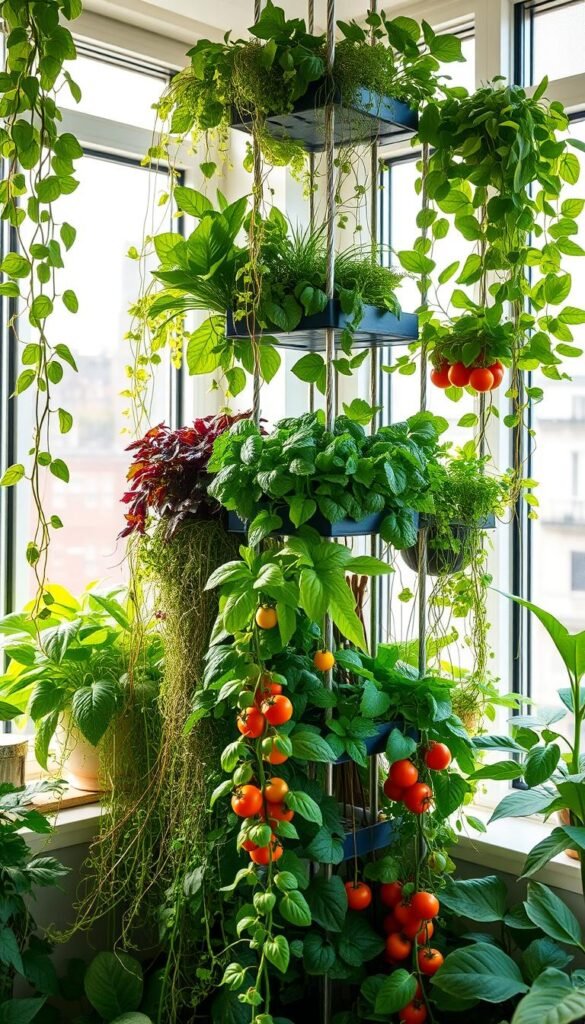
Turn blank walls into lush food forests using smart strategies that blend productivity with artistry. Even the smallest areas can burst with flavor when you rethink how and where things grow.
Reach New Heights with Vertical Solutions
Vertical gardening transforms unused surfaces into thriving edible displays. Picture strawberry plants spilling from wall pockets while peas climb repurposed ladders. Trailing cherry tomatoes work beautifully in hanging baskets, freeing up ground space for leafy greens.
For urban dwellers, PVC pipe systems offer modern flair. Drill planting holes and stack them vertically for a cascading lettuce wall.
“A well-designed vertical system can yield 20% more than traditional beds,”
notes urban farming expert Michael Bauer.
Smart Partnerships for Healthier Harvests
Companion planting creates natural pest barriers while boosting yields. Try these dynamic duos:
- Basil + tomatoes (improves flavor and repels flies)
- Nasturtiums + cucumbers (traps aphids)
- Chives + carrots (deters carrot flies)
Marigolds make colorful bodyguards, their roots secreting nematode-fighting compounds. For small-space growers, mixing herbs like thyme and oregano with flowers adds beauty while confusing pests.
Remember to rotate crops seasonally. Swap summer’s beans for fall kale, keeping your growing space productive and visually engaging year-round.
Exploring Innovative Garden Layouts and Design Elements
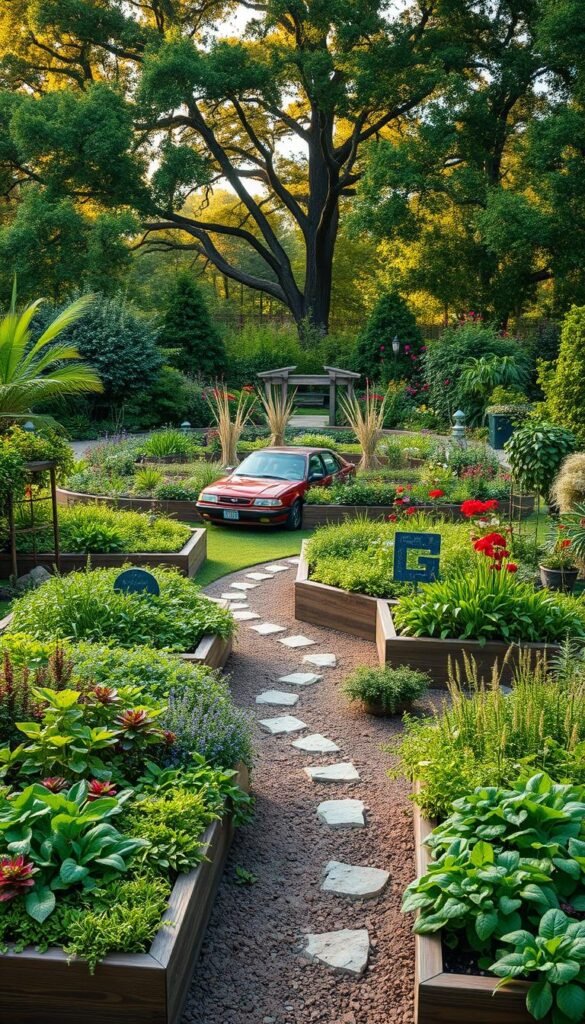
Innovative layouts turn even the smallest plots into efficient, eye-catching food havens. By blending modern techniques with creative flair, you can transform ordinary spaces into visually striking ecosystems that deliver both beauty and bounty.
Modern approaches using raised beds, hydroponics, and upcycled materials
Raised beds reinvent growing spaces with clean lines and smart organization. Geometric concrete block systems stack like LEGO bricks, creating tiered herb displays that double as sculptural elements. These structures maximize airflow and root space while adding architectural interest to your landscape.
For water-wise solutions, try vertical PVC hydroponic towers. These space-age systems grow leafy greens 30% faster than soil methods, perfect for maximizing your small space. Their modular design lets you expand upward as your ambitions grow.
Upcycled materials spark both sustainability and charm:
- Painted tires become rainbow-hued strawberry planters
- Wooden crates form modular veggie grids
- Salvaged ladders transform into vertical pea trellises
Inject color through strategic pairings—purple kale against orange marigolds, or scarlet runner beans climbing cobalt-blue poles. These combinations create visual interest while naturally deterring pests.
Grid-based layouts with cedar dividers keep plants organized yet artistic. Alternate sections of edible flowers with compact veggies like radishes, crafting patterns that please the eye and the palate. As seasons change, swap crops to maintain visual interest year-round.
Bringing Your Garden Vision to Life and Beyond

Envision plucking juicy berries beside your patio while their bushes dazzle with autumn crimson. Your edible landscape evolves through seasons, offering fresh snacks and visual drama from spring’s first shoots to winter’s frost-kissed kale.
Start with summer stars like golden ‘Sungold’ tomatoes tumbling over arches. Pair them with purple basil and flowering oregano—these thrive in heat while attracting pollinators. Come fall, rainbow chard’s neon stems outshine fading flowers, and artichokes become icy sculptures under morning frost.
Berry bushes work triple duty: blueberry blossoms feed bees in spring, fruits sweeten your table in summer, and fiery leaves brighten gray days. Dwarf apple trees anchor spaces with spring blooms and autumn snacks, proving small-stature trees deliver big impact.
No need to replant everything at once. Swap one ornamental shrub for an alpine strawberry border—its tiny fruits pack intense flavor. Replace annuals with ‘Redbor’ kale, whose ruffled leaves deepen in color as temperatures drop.
Your backyard becomes a living calendar, marking time through pear blossoms and persimmon harvests. Each plant’s growth habit and seasonal shifts create endless interest, blending nourishment with nature’s artistry.

